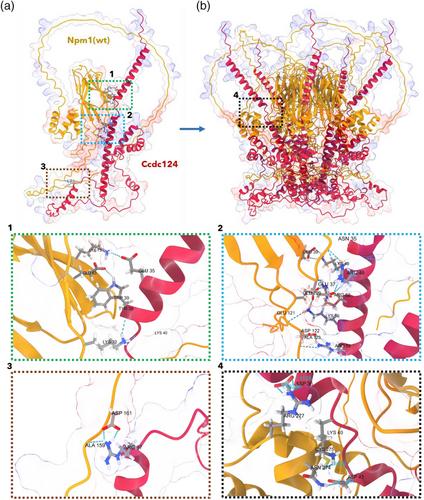Proteomics analysis identifies the ribosome associated coiled-coil domain-containing protein-124 as a novel interaction partner of nucleophosmin-1
Abstract
Background Information
Coiled-coil domain-containing protein-124 (Ccdc124) is a conserved eukaryotic ribosome-associated RNA-binding protein which is involved in resuming ribosome activity after stress-related translational shutdown. Ccdc124 protein is also detected at cellular localizations devoid of ribosomes, such as the centrosome, or the cytokinetic midbody, but its translation-independent cellular function is currently unknown.
Results
By using an unbiased LC-MS/MS-based proteomics approach in human embryonic kidney (HEK293) cells, we identified novel Ccdc124 partners and mapped the cellular organization of interacting proteins, a subset of which are known to be involved in nucleoli biogenesis and function. We then identified a novel interaction between the cancer-associated multifunctional nucleolar marker nucleophosmin (Npm1) and Ccdc124, and we characterized this interaction both in HEK293 (human embryonic kidney) and U2OS (osteosarcoma) cells. As expected, in both types of cells, Npm1 and Ccdc124 proteins colocalized within the nucleolus when assayed by immunocytochemical methods, or by monitoring the localization of green fluorescent protein-tagged Ccdc124.
Conclusions
The nucleolar localization of Ccdc124 was impaired when Npm1 translocates from the nucleolus to the nucleoplasm in response to treatment with the DNA-intercalator and Topo2 inhibitor chemotherapeutic drug doxorubicin. Npm1 is critically involved in maintaining genomic stability by mediating various DNA-repair pathways, and over-expression of Npm1 or specific NPM1 mutations have been previously associated with proliferative diseases, such as acute myelogenous leukemia, anaplastic large-cell lymphoma, and solid cancers originating from different tissues.
Significance
Identification of Ccdc124 as a novel interaction partner of Nmp1 within the frame of molecular mechanisms involving nucleolar stress-sensing and DNA-damage response is expected to provide novel insights into the biology of cancers associated with aberrations in NPM1.


 求助内容:
求助内容: 应助结果提醒方式:
应助结果提醒方式:


